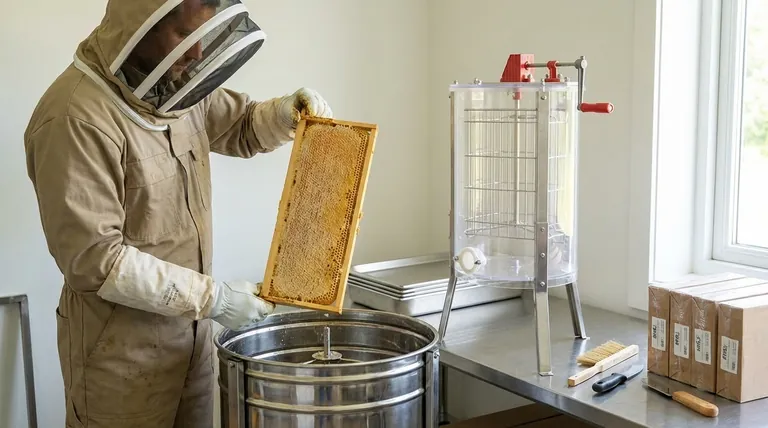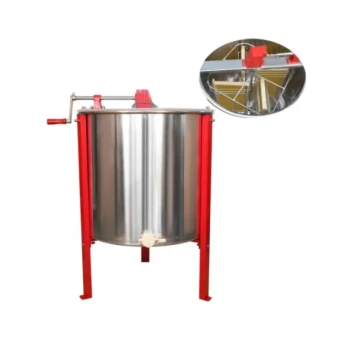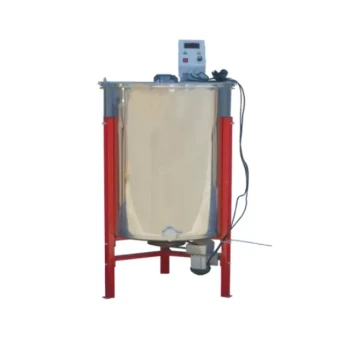To prepare frames for honey extraction, you must first have all your equipment ready, then systematically and calmly remove the bees from the honey-filled frames. Once the frames are clear of bees, they must be immediately secured in a sealed container for transport to your designated extraction area, often called a "honey house." This ensures a clean, efficient process and prevents opportunistic robbing by other bees.
The core principle of preparing frames for extraction is methodical readiness. A successful and stress-free harvest depends entirely on having the right tools assembled and a clear plan for removing bees and transporting frames before you open the hive.

Step 1: Assemble Your Extraction Toolkit
Before you approach the hive, every piece of equipment should be clean and ready. This preparation prevents frantic searching and minimizes the time your hive is open and vulnerable.
Essential Gear for Bee Removal
Your first task is to separate the bees from the honey. You will need a tool specifically for this purpose.
The most common options are a soft bee brush for manually clearing frames one by one, or a triangle bee escape board, which acts as a one-way door to clear the entire honey super over 24-48 hours.
Tools for Uncapping the Frames
The wax cappings on the honeycomb cells must be removed to release the honey.
Key uncapping tools include an uncapping knife (which can be heated or cold), a cappings scratcher or fork for low spots the knife might miss, and an uncapping tank or large food-grade bucket to collect the wax cappings and dripping honey.
Equipment for Extraction and Straining
This is the gear for the main event. You'll need a honey extractor to spin the honey out of the frames using centrifugal force.
You will also need a sieve or filter system (like cheesecloth or dedicated honey filters) and a bottling bucket with a honey gate to hold the filtered honey before it's jarred.
Step 2: Clearing Bees from the Honey Supers
Gently and efficiently removing bees from the frames you intend to harvest is the most critical hands-on step. There are two primary methods.
Method 1: The Bee Brush
This is a direct, manual approach. You pull one frame at a time, hold it over the open hive, and use a soft bee brush to gently sweep the bees off the comb and back into the hive.
This method is fast for harvesting just a few frames but can be more disruptive to the colony.
Method 2: The Bee Escape Board
This method is less invasive. An escape board is placed between the honey supers and the brood boxes a day or two before your planned harvest.
Bees can travel down through the one-way escape but cannot get back up into the honey supers. When you return, the frames will be almost entirely free of bees, making removal calm and simple.
Step 3: Secure and Transport Your Frames
Once a frame is cleared of bees, it must be protected immediately. Exposed honey will quickly attract bees from your hives and surrounding areas, leading to a "robbing frenzy."
The Importance of a Sealed Container
Place each bee-free frame directly into a closed, sealed box or an empty hive body with a secure lid for transport.
This simple step is crucial for maintaining a calm apiary and ensuring your honey remains clean.
Preparing Your Extraction Space
Your extraction area, or "honey house," should be a clean, indoor space that can be sealed off from any wandering bees.
Ensure your uncapping tank, extractor, and filtering buckets are all set up and ready before you bring the honey-filled frames inside.
Understanding the Trade-offs
While using a standard extractor is the most common method for hobbyists, it's essential to understand its context and the alternatives.
The Extractor-Based Method
This process, outlined above, allows you to preserve the drawn-out comb on the frames. Wired frames are particularly durable and hold up well to the force of the extractor.
Because bees expend significant energy to build wax comb, returning the empty "wet" frames to them gives them a massive head start on the next honey flow.
Post-Extraction Frame Management
After extraction, the frames are "wet" with a thin layer of residual honey. You can place these wet frames back in the hive for the bees to clean up.
This not only prevents pests from being attracted to the stored frames but also provides the bees with valuable resources.
Alternative: The Crush and Strain Method
For beekeepers without an extractor, this is a low-cost option. You simply crush the entire comb, wax and all, and let the honey drain out through a sieve or cheesecloth.
The significant trade-off is that the wax comb is destroyed, forcing the bees to rebuild it from scratch, which can reduce subsequent honey production.
Making the Right Choice for Your Goal
Your approach to the harvest should align with your beekeeping goals and the equipment you have available.
- If your primary focus is speed and hive productivity: Use a bee escape board to clear the supers and an extractor to preserve the comb.
- If you are a new beekeeper harvesting only a few frames: Manually clearing bees with a brush is a viable option, and the crush-and-strain method can be used if you haven't invested in an extractor.
- If your primary focus is minimizing bee disturbance: The bee escape board is the gentlest method for clearing bees from the frames.
Ultimately, a well-prepared and organized extraction process protects your bees, your honey, and your sanity.
Summary Table:
| Step | Key Action | Essential Equipment |
|---|---|---|
| 1. Preparation | Assemble all necessary, clean equipment. | Bee brush/escape board, uncapping knife, extractor, filters. |
| 2. Bee Removal | Gently clear bees from honey supers. | Bee brush (manual) or bee escape board (passive). |
| 3. Transport | Immediately secure frames in sealed containers. | Empty hive body or sealed box with a lid. |
| 4. Extraction | Uncap, spin, and filter honey in a bee-proof space. | Uncapping tank, honey extractor, sieve/bottling bucket. |
Ready to streamline your honey harvest? The right equipment makes all the difference. At HONESTBEE, we supply durable, commercial-grade beekeeping supplies and equipment to apiaries and distributors through our wholesale-focused operations. From bee brushes and escape boards to powerful extractors, we provide the tools you need for an efficient, high-yield harvest. Let's discuss your apiary's needs — contact our team today to get the right equipment for your operation.
Visual Guide

Related Products
- HONESTBEE 3-Frame Manual Acrylic Honey Extractor
- Stainless Steel Manual 8 Frame Radial Honey Extractor Machine for Beehives
- HONESTBEE 72 Frame Industrial Electric Honey Extractor for Beekeeping
- 6 Frame Manual Stainless Steel Honey Extractor Beekeeping Equipment
- 8-Frame Electric Self-Reversing Honey Extractor Spinner for Commercial Honey Extraction Equipment
People Also Ask
- What is a fun and easy alternative to using a honey extractor for harvesting honey? Try the Crush and Strain Method
- How often do beekeepers collect honey? Maximize Your Hive's Sustainable Yield
- What is the most common method for cleaning a honey extractor? Protect Your Honey & Equipment
- What machines are needed in beekeeping besides basic tools? Scale Your Honey Harvest Efficiently
- What size honey extractor do I need? Match Frame Capacity to Your Hives for Maximum Efficiency



















